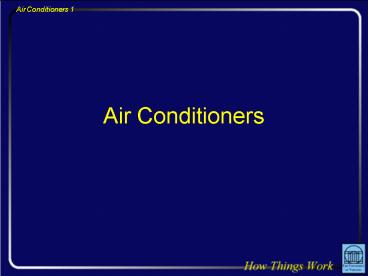Air Conditioners - PowerPoint PPT Presentation
1 / 24
Title:
Air Conditioners
Description:
Air conditioners. use work to transfer heat from cold to hot. are a type of heat pump ... as hot, high pressure gas. Air Conditioners 20. Condenser, Part 1 ... – PowerPoint PPT presentation
Number of Views:4690
Avg rating:1.0/5.0
Title: Air Conditioners
1
Air Conditioners
2
Question
- If you operate a window air conditioner on a
table in the middle of a room, the average
temperature in the room will - become colder
- become hotter
- stay the same
3
Observations AboutAir Conditioners
- They cool room air on hot days
- They emit hot air from their outside vents
- They consume lots of electric power
- They are less efficient on hotter days
- They can sometimes heat houses, too
4
Heat Machines
- Air conditioners
- use work to transfer heat from cold to hot
- are a type of heat pump
- Automobiles
- use flow of heat from hot to cold to do work
- are a type of heat engine
5
Thermodynamics
- Rules governing thermal energy flow
- Relationships between
- thermal energy and mechanical work
- disordered energy and ordered energy
- Codified in four laws of thermodynamics
6
0th Law
- Law about Thermal Equilibrium
- If two objects are in thermal equilibrium with
a third object, then they are in thermal
equilibrium with each other.
7
1st Law
- Law about Conservation of Energy
- Change in internal energy equals heat in minus
work out - where
- Internal energy thermal stored energies
- Heat in heat transferred into object
- Work out external work done by object
8
Order versus Disorder
- It is easy to convert ordered energy into thermal
(disordered) energy - It is hard to converting thermal energy into
ordered energy - Statistically, order to disorder is one-way
9
Entropy
- Entropy is measure of objects disorder
- Includes both thermal and structural disorders
- Isolated systems disorder never decreases
- But entropy can move or be transferred
10
2nd Law
- Law about Disorder (Entropy)
- Entropy of a thermally isolated system never
decreases
11
3rd Law
- Law about Entropy and Temperature
- An objects entropy approaches zero as its
temperature approaches absolute zero
12
More on the 2nd Law
- According to the 2nd Law
- Entropy of a thermally isolated system cant
decrease - But entropy can be redistributed within the
system - Part of the system can become hotter while
another part becomes colder!
13
Natural Heat Flow
- Heat naturally flows from hot to cold
- Removing heat from a hot object, entropy
- Adding heat to a cold object, entropy
- Entropy of combined system increases
- 1 J of thermal energy is more disordering to a
cold object than to a hot object
14
Unnatural Heat Flow
- Heat cant naturally flow from cold to hot
- Removing heat from cold object, entropy
- Adding heat to hot object, entropy
- More entropy removed than added
- Energy is conserved, but total entropy
- To save 2nd law, we need more entropy
- Ordered energy must become disordered
15
Air conditioners, Part 1
- Moves heat against its natural flow
- Flows from cold room air to hot outside air
- Converts ordered into disordered energy
- Doesnt decrease the worlds total entropy!
- Uses fluid to transfer heat working fluid
- Fluid absorbs heat from cool room air
- Fluid releases heat to warm outside air
16
Air conditioners, Part 2
- Evaporator located in room air
- transfers heat from room air to fluid
- Condenser located in outside air
- transfers heat from fluid to outside air
- Compressor located in outside air
- does work on fluid and creates entropy
17
Evaporator, Part 1
- Heat exchanger made from long metal pipe
- Fluid approaches evaporator
- as a high pressure liquid near room temperature
- A constriction reduces the fluids pressure
- Fluid enters evaporator
- as a low pressure liquid near room temperature
18
Evaporator, Part 2
- Working fluid evaporates in the evaporator
- Breaking bonds uses thermal energy
- Fluid becomes colder gas
- Heat flows from room air into fluid
- Fluid leaves evaporator
- as a low pressure gas near room temperature
- Heat has left the room!
19
Compressor
- Working fluid enters compressor
- as a low pressure gas near room temperature
- Compressor does work on fluid
- Pushes gas inward as the gas moves inward
- Gas temperature rises (first law)
- Ordered energy becomes disordered energy
- Fluid leaves compressor
- as hot, high pressure gas
20
Condenser, Part 1
- Heat exchanger made from metal pipe
- Fluid enters condenser
- as a hot, high pressure gas
- heat flows from fluid to outside air
21
Condenser, Part 2
- Working Fluid condenses in condenser
- forming bonds releases thermal energy
- Fluid becomes hotter liquid
- More heat flows from fluid into outside air
- Fluid leaves condenser
- as high-pressure room-temperature liquid
- Heat has reached the outside air!
22
Air conditioner Overview
- Evaporator located in room air
- transfers heat from room air to fluid
- Compressor located in outside air
- does work on fluid, so fluid gets hotter
- Condenser located in outside air
- transfers heat from fluid to outside air,
- including thermal energy extracted from inside
air - and thermal energy added by compressor
23
Question
- If you operate a window air conditioner on a
table in the middle of a room, the average
temperature in the room will - become colder
- become hotter
- stay the same
24
Summary AboutAir Conditioners
- They pump heat from cold to hot
- They dont violate thermodynamics
- They consume ordered energy
- They are most efficient for small temperature
differences































